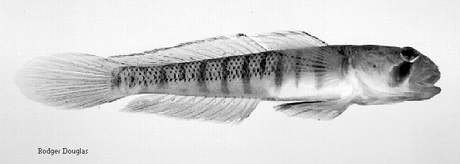|
[GOBIES]
|
|
|
|
67a
|
(42) |
Pelvic fins close together, fused to form a single cup-like structure under the abdomen
~ Family Gobiidae
|
[68]
|
|
67b
|
|
Pelvic fins not united. Head broad, depressed, with thick lips and projecting lower jaw. Dorsal fins well separated, the first with 6 spines, the second with 10 rays. Color brownish. To 23 cm (9 in). Common in estuaries and lower stream reaches. ‘O‘opu ‘akupa [End]
~ Family Eleotridae
Eleotris sandwicensis Vaillant & Sauvage, 1875
|
|
|
|
|
~~~~~~~~~~~~~~~~~~~~~~~~~~~~~
|
|
68a
|
(67) |
Pelvic fins forming a nearly circular disc (like a sucker) which is closely attached to body all around
|
[69]
|
|
68b
|
|
Pelvic fins forming a cup free from body on posterior margin
|
[70] |
|
|
|
~~~~~~~~~~~~~~~~~~~~~~~~~~~~~
|
|
69a
|
(68) |
Body covered by scales. Head blunt, eye small. Color dark olive-green with faint black bands across back. Fairly rare: generally found only in pristine, mountain streams. `O`opu nopili [End]
Sicyopterus stimpsoni (Gill)
|
|
|
69b
|
|
Body without scales or nearly so, purplish-brown in color. Breeding males with posterior half of body a brilliant red color. Rare: generally only in pristine, mountain streams. `O`opu `alamo`o, `o`opu hi`ukole [end]
Lentipes concolor (Gill)
|
|
|
|
|
~~~~~~~~~~~~~~~~~~~~~~~~~~~~~
|
|
70a
|
(68) |

A distinct black blotch extending below eye downward and backward on cheek. Anal and soft dorsal fins very long; anal rays 13. Found in lowland reaches of most streams. `O`opu naniha [end]
Stenogobius hawaiiensis Watson
|
|
|
70b
|
|
No distinct black blotch on cheek
|
[71] |
|
|
|
~~~~~~~~~~~~~~~~~~~~~~~~~~~~~
|
|
71a
|
(70) |
Head broad with large mouth directed somewhat downward. Color dark olive-brown; very mottled in juveniles. Fins marked with dark stripes; anal fin rays 10. Found in lower to middle reaches of most streams. `O`opu nakea [ind]
Awaous guamensis (Valenciennes)
|
|
|
71b
|
|
Head blunt with large mouth directed forwards or somewhat upwards. Color gray or brown, mottled olive-brown with indistinct bands radiating out from eyes. Dorsal fins edged in black and white. Under 5 cm (2 in). Found in lower part of some streams and estuaries
Mugilogobius cavifrons Weber
|
|
|
|
|
|
|
72a
|
(42) |
Spiny dorsal fin with 4 spines and clearly separate from soft dorsal fin located further back on body. Pectoral fins placed high, above midline. Marine and brackish water, in estuaries and lagoons. Mullet
~ Family MUGILIDAE
|
[35] |
|
72b
|
|
Spiny and soft dorsals may be distinct, with a notch between, but are not widely separated along the back. Pectorals at or below midline of body
|
[73] |
|
|
|
~~~~~~~~~~~~~~~~~~~~~~~~~~~~~
|
|
73a
|
(72) |
Front dorsal with 9-10 spines distinct from, but not separated from, soft dorsal. Silvery fish with large eyes and forked tail (tail banded in young individuals). Common in lower reaches of streams and estuaries as juveniles; marine as adults. Aholehole or Hawaiian flagtail [end]
~ Family KUHLIIDAEKuhlia sandvicensis (Steindachner)
|
|
|
73b
|
|
Dorsal fin long, usually with two lobes. Anal fin with 3 spines in addition to rays. Freshwater ~ Family CENTRARCHIDAE
|
[74] |
|
Key to Family Centrarchidae
|
|
|
Family CENTRARCHIDAE ~ Bass and sunfish
|
|
|
[BASS & SUNFISH]
|
|
|
| |
74a
|
(73) |
Jaws large, upper jaw extending to below eye or further back. Length of body greater than 3 times height. Either no or only faint spot on upper edge of operculum. Distinct notch between spiny and soft parts of dorsal fin. {Caudal fin multicolored in juveniles
|
[75]
|
|
74b
|
|
Jaws small, upper jaw not reaching as far back as eye. Prominant black spot on upper edge of operculum. Length about 2 to 3 times height of body. {Only a shallow notch between spiny and soft dorsal. Caudal fin plain in juveniles. Some fresh water reservoirs. Bluegill
Lepomis macrochirus Rafinesque
|
|
|
|
|
~~~~~~~~~~~~~~~~~~~~~~~~~~~~~
|
|
75a
|
(74) |
Upper jaw extending to back of eye or further. Shortest dorsal spine at notch less than half the length of the longest spine. Lakes and reservoirs. Largemouth bass
Micropterus salmoides (Lacepede)
|
|
|
75b
|
|
Upper jaw extending to about middle of eye. Shortest dorsal spine at notch more than half the length of the longest spine. Lakes, reservoirs, and streams. Smallmouth bass
Micropterus dolomieui Lacepede
|
|